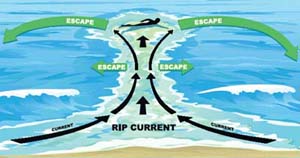| NOAA Magazine || NOAA Home Page |
NOAA,
U.S. LIFESAVING ASSOCIATION LAUNCH "BREAK THE GRIP OF THE RIP"
NATIONAL PUBLIC AWARENESS CAMPAIGN ON RIP CURRENTS
 May
24, 2004 — A new public awareness campaign launched today by NOAA
and the U.S. Lifesaving Association puts the spotlight on deadly rip
currents, helping beachgoers recognize them and offering potentially
life-saving tips on how to get out of them. (Click NOAA image
for larger view of how to safely swim out of a rip current. Click
here for high resolution version, which is a large file. Please credit
“NOAA.”)
May
24, 2004 — A new public awareness campaign launched today by NOAA
and the U.S. Lifesaving Association puts the spotlight on deadly rip
currents, helping beachgoers recognize them and offering potentially
life-saving tips on how to get out of them. (Click NOAA image
for larger view of how to safely swim out of a rip current. Click
here for high resolution version, which is a large file. Please credit
“NOAA.”)
At a news conference in Wrightsville, N.C., officials from NOAA, the U.S. Lifesaving Association, public officials and rip current researchers joined a family that had been devastated by a rip current-related death to call attention to this important national issue. According to the USLA, 80 percent of surf beach rescues are attributed to rip currents, and more than 100 people die annually from drowning when they are unable to escape a rip current.
“Rip currents are the leading safety hazard for beachgoers! On average, more people die every year by rip currents than to shark attacks or weather-related deaths, such as tornadoes, lightning, hurricanes or flooding,” said retired Navy Vice Adm. Conrad C. Lautenbacher, Ph.D., undersecretary of commerce for oceans and atmosphere and NOAA administrator.
“Teach your kids beach safety and how to act if they are in trouble in the water,” said Sandee LaMotte whose husband, a reporter for the Cable News Network, died trying to save their son from a rip current last year. Although her son was rescued, another good Samaritan lost his life in an attempt to save LaMotte's husband. “Eight families lost loved ones to rip currents on that day and it did not need to happen."
To help lifeguards identify potential rip current hazards, the NOAA National Weather Service began issuing Surf Zone Forecasts from many local NWS offices last summer.
“The Surf Zone Forecast’s Rip Current Outlook is communicated by many local NOAA National Weather Service offices to lifeguard agencies, beach patrols, emergency management officials, the media and the public,” said retired Air Force Brig. Gen. David L. Johnson, director of the NOAA National Weather Service. “Each Weather Forecast Office directly transmits the Surf Zone Forecast to the public through NOAA Weather Radio and local Web sites. Our standardized forecast ensures that consistent rip current information is available to beach goers along the Atlantic, Gulf and Pacific coasts.”
“Rip currents are dangerous because they are invisible to the untrained eye and can happen without warning. They are particularly dangerous for weak and non-swimmers,” said Chris Brewster, USLA president.
“More than 20 years of research has shown us that under certain wave, tide and beach conditions, rip currents can quickly become dangerous to anyone entering the surf,” said Wendy Carey, a Delaware Sea Grant rip current researcher. “Average rip current speeds of 1-2 feet per second can sweep even the strongest swimmer out to sea. Rip currents have been measured as fast as 8 feet per second, which is faster than an Olympic swimmer can sprint.”
NOAA and the USLA have developed a series of communications tools to help educate beachgoers about the threat of rip currents including outdoor signs for posting by municipalities along boardwalks and beachfronts and a "Break the Grip of the Rip" safety brochure.
Another valuable resource in this national awareness campaign is the new NOAA rip currents Web site found at http://www.ripcurrents.noaa.gov. Elements of the new Web site include details on rip current science, safety tips, survivor stories, downloadable photos and graphics, public service announcements in English and Spanish and links to rip current research/statistics.
All of the communications tools call attention to how to identify rip currents, what to do when you see warning signs, how to avoid becoming a victim, what to do if you get caught in a rip current and how to help others who are caught.
NOAA is dedicated to enhancing economic security and national safety through the prediction and research of weather and climate-related events and providing environmental stewardship of the nationís coastal and marine resources. NOAA is part of the U.S. Department of Commerce.
Relevant
Web Sites
NOAA Rip Currents
Rip Current Public Service Announcements Videos: English;
Spanish
(Click here for text versions.)
Media
Contact:
Greg Romano, NOAA
National Weather Service, (301) 713-0622; Ben
Sherman, NOAA Ocean Service,
(301) 713-3066, ext. 178 or cell (202) 253-5256